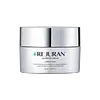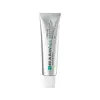What's inside
What's inside
 Key Ingredients
Key Ingredients

 Benefits
Benefits

 Concerns
Concerns

 Ingredients Side-by-side
Ingredients Side-by-side

Water
Skin ConditioningGlycerin
HumectantCaprylic/Capric Triglyceride
MaskingIsopropyl Palmitate
EmollientCyclopentasiloxane
EmollientButylene Glycol
HumectantPetrolatum
EmollientGlyceryl Stearate
EmollientCetyl Alcohol
EmollientButyrospermum Parkii Butter
Skin ConditioningGlyceryl Polyacrylate
1,2-Hexanediol
Skin ConditioningPvp
Emulsion StabilisingDimethicone
EmollientAlcohol Denat.
AntimicrobialBisabolol
MaskingCetearyl Alcohol
EmollientCeteareth-20
CleansingPEG-100 Stearate
Stearic Acid
CleansingPanthenol
Skin ConditioningSodium Hyaluronate
HumectantTocopheryl Acetate
AntioxidantIsopropyl Titanium Triisostearate
EmollientBis-PEG-15 Dimethicone/Ipdi Copolymer
PEG-2 Soyamine
EmulsifyingHydrolyzed Dna
Skin ConditioningAcrylates/C10-30 Alkyl Acrylate Crosspolymer
Emulsion StabilisingRetinyl Palmitate
Skin ConditioningSimmondsia Chinensis Seed Oil
EmollientSqualane
EmollientArgania Spinosa Kernel Oil
EmollientAloe Barbadensis Leaf Juice
Skin ConditioningGlycyrrhiza Glabra Root Extract
BleachingLavandula Angustifolia Flower/Leaf/Stem Oil
HumectantCitrus Aurantium Bergamia Peel Oil
Xanthan Gum
EmulsifyingSodium Hydroxide
BufferingLinalool
PerfumingLimonene
PerfumingEthylhexylglycerin
Skin ConditioningCitrus Paradisi Peel Oil
MaskingAdenosine
Skin ConditioningWater, Glycerin, Caprylic/Capric Triglyceride, Isopropyl Palmitate, Cyclopentasiloxane, Butylene Glycol, Petrolatum, Glyceryl Stearate, Cetyl Alcohol, Butyrospermum Parkii Butter, Glyceryl Polyacrylate, 1,2-Hexanediol, Pvp, Dimethicone, Alcohol Denat., Bisabolol, Cetearyl Alcohol, Ceteareth-20, PEG-100 Stearate, Stearic Acid, Panthenol, Sodium Hyaluronate, Tocopheryl Acetate, Isopropyl Titanium Triisostearate, Bis-PEG-15 Dimethicone/Ipdi Copolymer, PEG-2 Soyamine, Hydrolyzed Dna, Acrylates/C10-30 Alkyl Acrylate Crosspolymer, Retinyl Palmitate, Simmondsia Chinensis Seed Oil, Squalane, Argania Spinosa Kernel Oil, Aloe Barbadensis Leaf Juice, Glycyrrhiza Glabra Root Extract, Lavandula Angustifolia Flower/Leaf/Stem Oil, Citrus Aurantium Bergamia Peel Oil, Xanthan Gum, Sodium Hydroxide, Linalool, Limonene, Ethylhexylglycerin, Citrus Paradisi Peel Oil, Adenosine
Water
Skin ConditioningGlycerin
HumectantButylene Glycol
HumectantDicaprylyl Carbonate
EmollientDipropylene Glycol
HumectantDistarch Phosphate
AbsorbentCetearyl Alcohol
EmollientNiacinamide
SmoothingPolyglyceryl-3 Methylglucose Distearate
EmulsifyingCeramide AP
Skin Conditioning1,2-Hexanediol
Skin ConditioningSmilax Medica Root Extract
TonicCentella Asiatica Extract
CleansingOctyldodecanol
EmollientPentylene Glycol
Skin ConditioningHydroxyethyl Acrylate/Sodium Acryloyldimethyl Taurate Copolymer
Emulsion StabilisingBis-Diglyceryl Polyacyladipate-2
EmollientC12-15 Alkyl Benzoate
AntimicrobialDimethicone
EmollientHydroxyacetophenone
AntioxidantCetearyl Glucoside
EmulsifyingHydrolyzed Dna
Skin ConditioningAcrylates/C10-30 Alkyl Acrylate Crosspolymer
Emulsion StabilisingTromethamine
BufferingPanthenol
Skin ConditioningAdenosine
Skin ConditioningSodium PCA
HumectantMadecassoside
AntioxidantMagnesium PCA
HumectantZinc PCA
HumectantManganese PCA
HumectantDisodium EDTA
Alcohol Denat.
AntimicrobialPhenoxyethanol
PreservativePotassium Sorbate
PreservativeWater, Glycerin, Butylene Glycol, Dicaprylyl Carbonate, Dipropylene Glycol, Distarch Phosphate, Cetearyl Alcohol, Niacinamide, Polyglyceryl-3 Methylglucose Distearate, Ceramide AP, 1,2-Hexanediol, Smilax Medica Root Extract, Centella Asiatica Extract, Octyldodecanol, Pentylene Glycol, Hydroxyethyl Acrylate/Sodium Acryloyldimethyl Taurate Copolymer, Bis-Diglyceryl Polyacyladipate-2, C12-15 Alkyl Benzoate, Dimethicone, Hydroxyacetophenone, Cetearyl Glucoside, Hydrolyzed Dna, Acrylates/C10-30 Alkyl Acrylate Crosspolymer, Tromethamine, Panthenol, Adenosine, Sodium PCA, Madecassoside, Magnesium PCA, Zinc PCA, Manganese PCA, Disodium EDTA, Alcohol Denat., Phenoxyethanol, Potassium Sorbate
 Reviews
Reviews

Ingredients Explained
These ingredients are found in both products.
Ingredients higher up in an ingredient list are typically present in a larger amount.
1,2-Hexanediol is a synthetic liquid and another multi-functional powerhouse.
It is a:
- Humectant, drawing moisture into the skin
- Emollient, helping to soften skin
- Solvent, dispersing and stabilizing formulas
- Preservative booster, enhancing the antimicrobial activity of other preservatives
Acrylates/C10-30 Alkyl Acrylate Crosspolymer is a synthetic polymer. It is used to thicken and improve the texture of products. Due to its properties, it can prevent water and oil ingredients from separating.
Adenosine is in every living organism. It is one of four components in nucleic acids that helps store our DNA.
Adenosine has many benefits when used. These benefits include hydrating the skin, smoothing skin, and reducing wrinkles. Once applied, adenosine increases collagen production. It also helps with improving firmness and tissue repair.
Studies have found adenosine may also help with wound healing.
In skincare products, Adenosine is usually derived from yeast.
Learn more about AdenosineAlcohol Denat. is an alcohol with a denaturant property. It is created by mixing ethanol with other additives.
This ingredient gets a bad rep because it is irritating and drying - mostly due to its astringent property. Astringents draw out natural oils in tissue, constricting pores and leaving your skin dried out.
However, alcohol denat. is not all that bad.
Due to its low molecular weight, alcohol denat. tends to evaporate quickly. One study on pig skin found half of applied alcohol evaporated in 10 seconds and less than 3% stayed on skin.
This also helps other ingredients become better absorbed upon application.
Studies are conflicted about whether this ingredient causes skin dehydration. One study from 2005 found adding emollients to propanol-based sanitizer decreased skin dryness and irritation. Another study found irritation only occurs if your skin is already damaged.
Small amounts of alcohol are generally tolerated by oily skin or people who live in humid environments.
The rule of thumb is if this alcohol is near the end of an ingredients list, it will probably not affect your skin much.
Also...
This ingredient has antimicrobial and solvent properties.
The antimicrobial property helps preserve products and increase their shelf life. As a solvent, it helps dissolve other ingredients.
Other types of astringent alcohols include:
Learn more about Alcohol Denat.Butylene Glycol (or BG) is used within cosmetic products for a few different reasons:
Overall, Butylene Glycol is a safe and well-rounded ingredient that works well with other ingredients.
Though this ingredient works well with most skin types, some people with sensitive skin may experience a reaction such as allergic rashes, closed comedones, or itchiness.
Learn more about Butylene GlycolCetearyl alcohol is a mixture of two fatty alcohols: cetyl alcohol and stearyl alcohol. It is mainly used as an emulsifier. Emulsifiers help prevent the separation of oils and products. Due to its composition, it can also be used to thicken a product or help create foam.
Cetearyl alcohol is an emollient. Emollients help soothe and hydrate the skin by trapping moisture.
Studies show Cetearyl alcohol is non-toxic and non-irritating. The FDA allows products labeled "alcohol-free" to have fatty alcohols.
This ingredient is usually derived from plant oils such as palm, vegetable, or coconut oils. There is debate on whether this ingredient will cause acne.
Due to the fatty acid base, this ingredient may not be Malassezia folliculitis safe.
Learn more about Cetearyl AlcoholDimethicone is a type of synthetic silicone created from natural materials such as quartz.
What it does:
Dimethicone comes in different viscosities:
Depending on the viscosity, dimethicone has different properties.
Ingredients lists don't always show which type is used, so we recommend reaching out to the brand if you have questions about the viscosity.
This ingredient is unlikely to cause irritation because it does not get absorbed into skin. However, people with silicone allergies should be careful about using this ingredient.
Note: Dimethicone may contribute to pilling. This is because it is not oil or water soluble, so pilling may occur when layered with products. When mixed with heavy oils in a formula, the outcome is also quite greasy.
Learn more about DimethiconeGlycerin is already naturally found in your skin. It helps moisturize and protect your skin.
A study from 2016 found glycerin to be more effective as a humectant than AHAs and hyaluronic acid.
As a humectant, it helps the skin stay hydrated by pulling moisture to your skin. The low molecular weight of glycerin allows it to pull moisture into the deeper layers of your skin.
Hydrated skin improves your skin barrier; Your skin barrier helps protect against irritants and bacteria.
Glycerin has also been found to have antimicrobial and antiviral properties. Due to these properties, glycerin is often used in wound and burn treatments.
In cosmetics, glycerin is usually derived from plants such as soybean or palm. However, it can also be sourced from animals, such as tallow or animal fat.
This ingredient is organic, colorless, odorless, and non-toxic.
Glycerin is the name for this ingredient in American English. British English uses Glycerol/Glycerine.
Learn more about GlycerinWe don't have a description for Hydrolyzed Dna yet.
Panthenol is a common ingredient that helps hydrate and soothe the skin. It is found naturally in our skin and hair.
There are two forms of panthenol: D and L.
D-panthenol is also known as dexpanthenol. Most cosmetics use dexpanthenol or a mixture of D and L-panthenol.
Panthenol is famous due to its ability to go deeper into the skin's layers. Using this ingredient has numerous pros (and no cons):
Like hyaluronic acid, panthenol is a humectant. Humectants are able to bind and hold large amounts of water to keep skin hydrated.
This ingredient works well for wound healing. It works by increasing tissue in the wound and helps close open wounds.
Once oxidized, panthenol converts to pantothenic acid. Panthothenic acid is found in all living cells.
This ingredient is also referred to as pro-vitamin B5.
Learn more about PanthenolWater. It's the most common cosmetic ingredient of all. You'll usually see it at the top of ingredient lists, meaning that it makes up the largest part of the product.
So why is it so popular? Water most often acts as a solvent - this means that it helps dissolve other ingredients into the formulation.
You'll also recognize water as that liquid we all need to stay alive. If you see this, drink a glass of water. Stay hydrated!
Learn more about Water